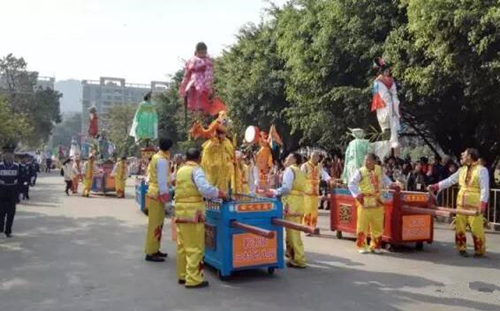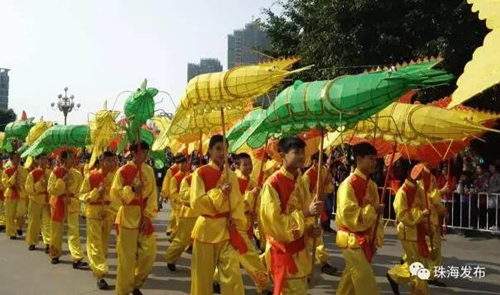Doumen heralds lively, spectacular Folk Art Parade
An eclectic mix of Zhuhai Lingnan and other Chinese cultures can be viewed when the 14th Doumen District Folk Art Parade steps off at Gree Fitness Square at 10 am on Saturday, March 3.
The square is the first performance site. From it, the first contingent will march down Xidi Road for another showing and then turn left toward GoTone Square on South Guangchang St.
The second group will follow Xidi Road, but then proceed along Fourth, Middle, and Third Jiangwan roads before looping back to Xidi to meet its predecessor at GoTone Square.

Lion Dance
Highlights of the parade:
Dragon Dance
Two fire dragons, one gold and the other silver, are powered by dancing teams from Lianzhou Town, along with four smaller dragons from Qianwu Town. Three different types of dragons interact, presenting quite a spectacle.

Dragon dance
Zhongshan Drunken Dragon Dance
Drunken Dragon Dance is popular in Zhongshan, Zhuhai, and Macao. It is held every 8th day of the 4th lunar month as part of the Festival of Bathing the Buddha. In 2006, it was listed among the first batch of Guangdong Provincial intangible cultural heritage items.
The performers drink rice wine while brandishing a wooden dragon head and tail. The dance, which integrates southern-style boxing, drunken boxing, and other stunts, urges the actors to reach a state known as "drunken body, sober mind; drunken steps, exceptional dance".
Imperial Kinsmen Sacrificial Rites
Since Chao K'uang-yin (Zhao Kuangyin) established the Song Dynasty (960-1279), the Imperial Kinsmen Sacrificial Rites have spread from the Central Plains to Dachikan and Nanmen of Doumen District, as well as neighboring areas. The Zhao Clan uses the rites to pay respect to ancestors at Spring Festival and on other major occasions at family shrines. The ancestor-worship, known as Sacrificial Rites of Imperial Family, was designated a Guangdong Provincial intangible cultural heritage item in 2016.

The Imperial Kinsmen Sacrificial Rites
Chinese Opera & Piaose
This matrix blends Chinese opera and Piaose Street Procession to create a distinct visual effect while also showcasing Doumen's charm as the hometown of Chinese Opera.

Piaose Street Procession
Piaose is a unique art integrating drama, magic, acrobatics, music, and dance. Children aged seven to nine dress up as characters from folklore or fairytales and are held aloft on hidden poles to create the illusion of floating in air.
Water Town Impression
Performers showcase Doumen's water town culture and folk customs, acting as fisher girls, sails, shrimp lanterns, fish lanterns, and lotus ladies.

Water Town Impression matrix
On-Water Wedding
On-Water Wedding was the first in Zhuhai to be designated as a state-level intangible cultural heritage item. It features bridegrooms, brides, bridesmaids, groomsmen, and boatmen in land boats.
The protocol involves worshipping the Dragon King, meeting the bride, striding over a burning basin, and bowing to mutual parents.
Northeast Yangko by Xiangzhou District
Yangko is a folk dance from northern China. It was created to ease the monotony of transplanting rice seedlings and ploughing fields. It also formed part of an ode to the gods in ancient times in hopes of a bountiful harvest.
Embodying the passion of the Northeastern Chinese performers, the dance features red, green, or other colorful costumes with red silk ribbons tied around the waist. Performers swing their bodies to trumpet, drum, small cymbal, and suona rhythms.
Huazhou Exorcizing Dance
Huazhou Exorcizing Dance is performed in ghost masks, unique costumes, and other adornments. It is designed to drive away demons, disease, and other evil influences, and to petition for blessings from the gods.
It originated in Fuzhou, capital of Fujian, before spreading south to Guangdong's Huazhou in the late Ming Dynasty (1368-1644). In 2011, it was listed among the third batch of state-level intangible cultural heritage items by the State Council.
Residential Community & Waterfront Dweller
This square formation is comprised of local community residents and waterfront dwellers showcasing characteristic local folk culture as well as a harmonious social atmosphere.
Gong & Drum Cabinet Parade
The highlight of the local musical performance is the Gong & Drum Cabinet Parade, also known as the Bayin (Eight Note) Cabinet. It was designated as a municipal intangible cultural heritage item in 2007.
Lion Dance
Lion Dance was included among the third-batch of intangible cultural heritage items under city-level protection in June 2010. Highly popular, the stereoscopic lion group at the tail end of the parade integrates martial arts, dance, and music, and symbolizes the ever-increasing quality of life among Zhuhai residents.

Lion dance show [Photos courtesy Zhuhai Daily]
The performance culminates with a Long Drum Dance from Liannan Yao Autonomous County of Guangdong's Qingyuan as well as a demonstration of the unique ethnic culture of Lisu from Nujiang Lisu Autonomous Prefecture of Yunnan Province.
The parade is organized by the district Publicity Department and Bureau of Culture, Radio, Film, Television, Press & Publication under the guidance of the Zhuhai Culture, Sports & Tourism Bureau and the city Publicity Department. The Doumen Intangible Cultural Heritage Protection Center oversees the event.



